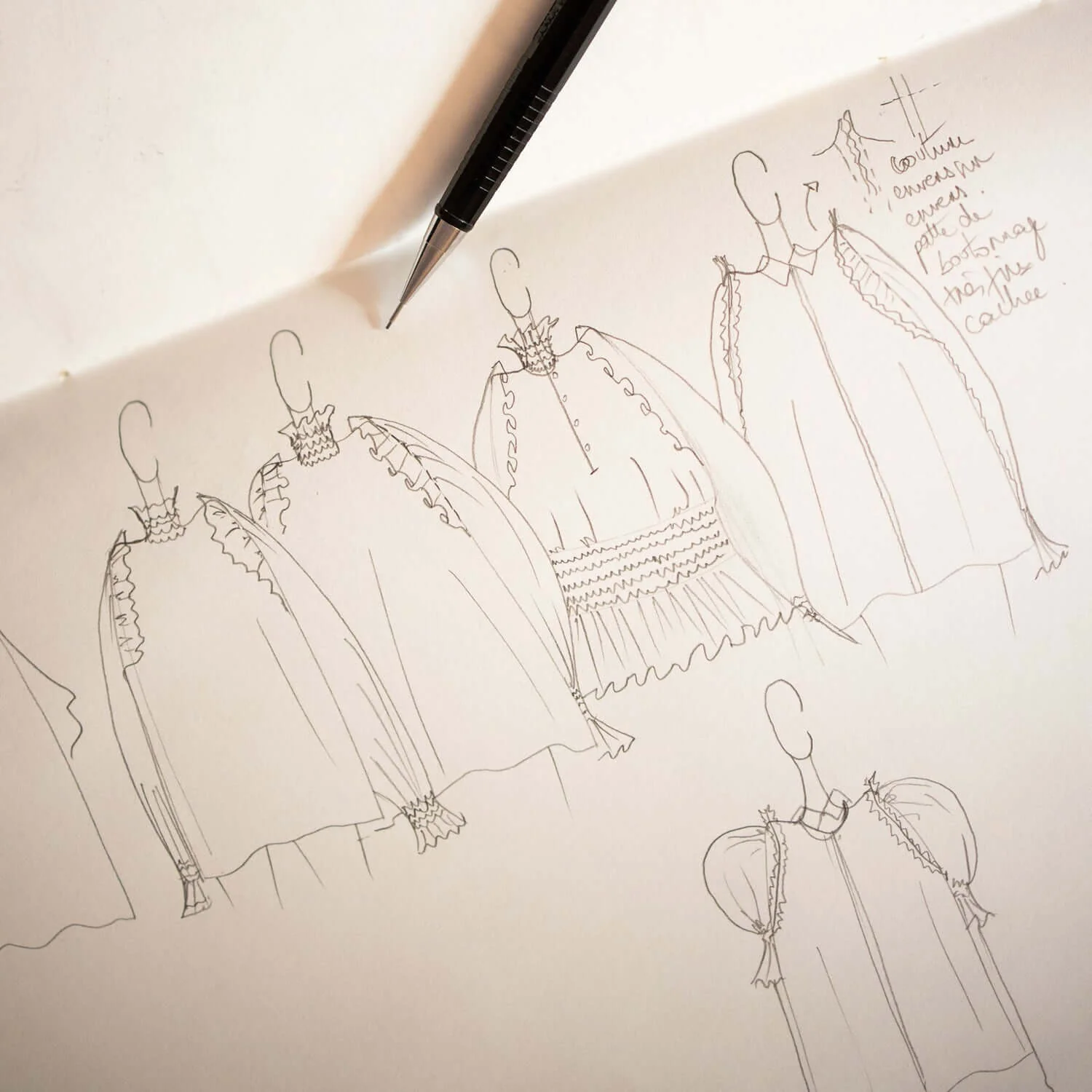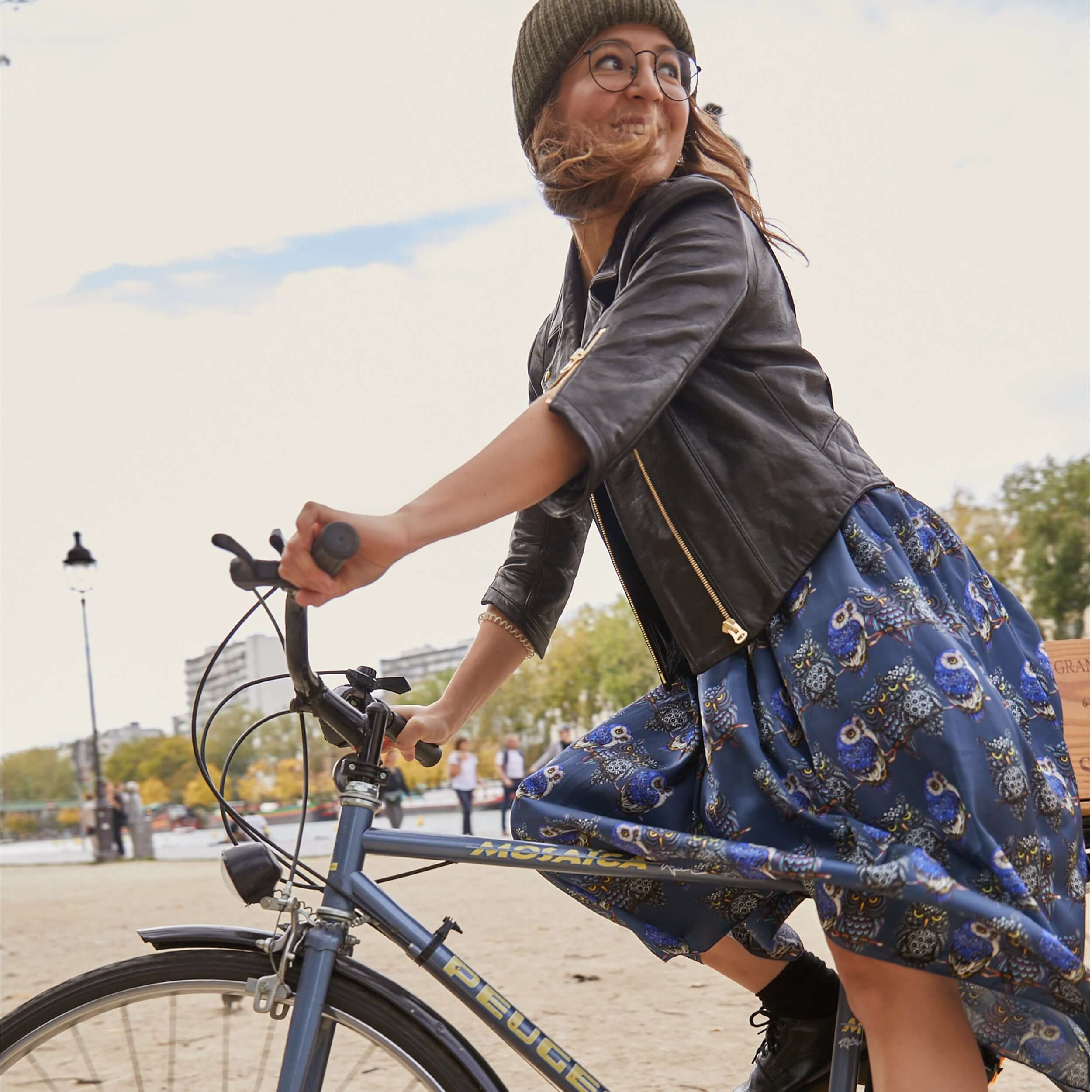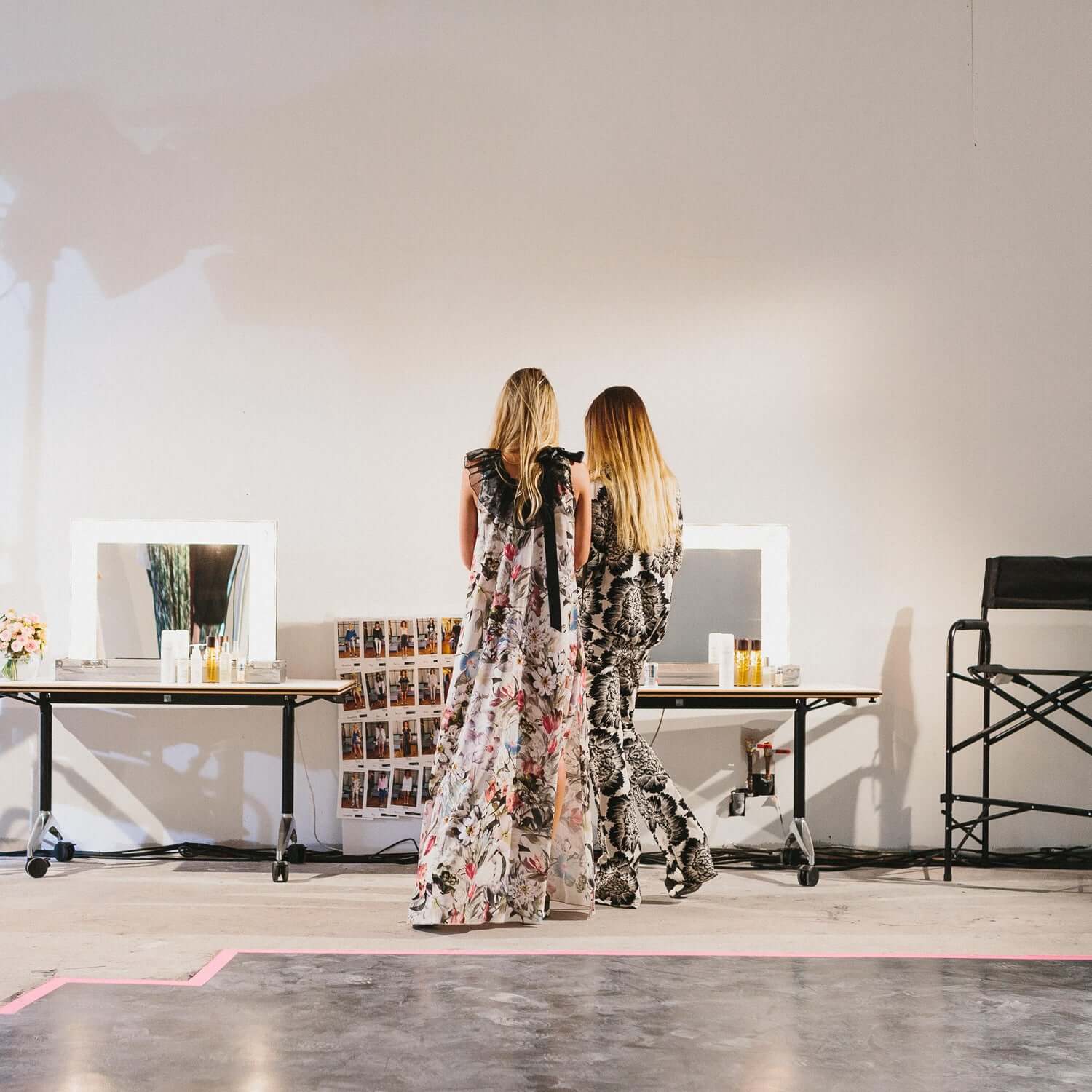#empowerwomenthroughcreativity
You may have understood by now that what we are looking for at Heimstone is to build our collections with intelligence and sensitivity, without betraying who we truly are. So here, to conclude this trilogy, I would like to take you backstage, behind the scene, to see the creation of a collection, to explain the choices we make and show you what we believe in, as well as all the actions we take to improve our sustainability, respecting the people and the environment as much as possible. For today and tomorrow.
Heimstone today
About the depth of our collections
When I draw my prints, I imagine them coming to life on silhouettes, on you - it's a moment of intense excitement and I often want to create a thousand pieces! Of course, the reality is a bit different.
We carefully sort and choose items that we know you will truly love. However, I do not restrict my creativity and my imagination; and of course, we always think about the seasonality of our different capsules.
The construction of our collection has also evolved a lot over time to be able to offer you more themes, more prints and colors (a great game for me!) while controlling our growth.

When the summer 2017 collection was launched, we decided to divide our collection into three capsules, which meant three "small" launches over six months. This allowed us to respond in a better way to your desires for new products and above all to communicate more about the history, mood and seasonality of each of these capsules.
Today, in 2020, that has not really changed, except that we have divided again these three capsules into three mini capsules (following me here!?, we now have a collection divided into nine steps). It’s even better for me as I can more easily tell you about the inspirations behind each print.
Thus, over the past three years, the size of our collections has only really increased by 20-25%. We had between thirty and forty items per collection, declined in the past in one, two, sometimes three different fabrics maximum.
Today this same number of references is available in one, two, three, four, sometimes five different fabrics, which gives the impression that the collections are much larger! In fact, they are simply more diverse and spread out in time. Magic, right?
Finally, if the number of designs per collection has not really increased (our Dori, our Gil, our Austria, our Bobbi etc…), we have managed to offer you more choices, more variations - and that delights me!
To determine the quantities to produce by item we obviously rely on statistics recorded for years, but above all, the whole Heimstone team meets and reviews each model design, each print in order to choose, and feel which would be your favorites or not! Sometimes it’s a hit and miss, and sometimes a print we were not betting on becomes a bestseller... it's the game!
In fact, I’m obsessed to see a garment worn. I have no interest in creating clothes that I would not sell, because they would end up sleeping in a warehouse, would be useless, expensive and polluting!
And when we have a few pieces left, you have guessed: we keep them in a safe place for our outlets. We like the idea that Heimstone is getting older with you, that you remember pieces from previous collections, and that each piece was acquired like a little treasure. Also, from the very beginning of Heimstone, we have been giving a part of our archives to ARCAT (the Association for Research, Communication and Action for access to Treatments) which have been our partners for years. In the future, I would like to collaborate with new NGO, related to causes that I feel more and more concerned with, such as the protection of the oceans, we started with our support to #the100kinitiative, but also child protection. If you already support the work of charities that matter to you, do not hesitate to share them with us in comments!
About our tailoring
For a long time, we have favored French tailoring (even Parisian in fact!). 50% of our collections are produced in our workshops in the Paris suburbs where I know that the working conditions are good, where the seamstresses now know our designs almost by heart. It’s extremely important to us. A little secret, for example: on our sleeveless Java summer dress, the shoulder strap is so thin that only one seamstress perfectly masters the technique to obtain a clean seam, and we rely on her every season. What a great talent.
The remaining 50% is produced in Poland (25%), India (5%), Portugal for our accessories (20%) - in short, places we seek out for a particular skills (such as embroidery for our streetwear capsule or for the precision and structure of our stitched pleats on the Muse shirt).
When a production is done, we still work in a very artisanal way: Anastasia and Léa, our collection & production managers (who rock!), go themselves for the final quality control and they bring the pieces back to the shop. This allows us to limit round trips and polluting transport, and that way, we don’t need any transport polybags (which is nice, as it means less waste!). We work on a human scale. In Poland, our representative on-site ensures this same quality control.
About our supplies and clothing stocks
We control the quantities produced and our orders. First of all, because this is how I built Heimstone: I wanted unique and exclusive silhouettes (I want you to feel special in our clothes). We really produce each design in small quantities, our pieces are almost unique.

The second reason is the desire to produce as if it was "on-demand": if our production requires thirty zippers, we do not order more. The idea is to work with zero stock, we don't want to produce any waste! And if we choose to produce 50 dresses of a particular design, we order the fabric accordingly and when a print is sold out, it is sold out for good! There has only been a few cases when we overestimated our need of fabric and we were lucky enough to be able to produce a few extra pieces.
We do not produce a printed roll again in this zero stock philosophy.
What you do not see is that this approach is already a commitment in itself within the textile industry for a more rational consumption. In fact, it restricts the choice of suppliers who are used to work on a very large scale and impose enormous, absurd minimum quantities. The best example of this is a type of embroidery that we just cancelled for next summer, that we all adored in the team but the supplier tried to impose a minimum order on us that seemed excessive. We thought it was more fair to cancel it.
Local production, zero waste logic and controlled consumption are my idea of a more sustainable commitment with Heimstone and I think it's already quite good. And when you buy a Heimstone piece, in-store or behind your screen, you also make this commitment with us (remember the first article: your purchase, your power).
Because we want to go much further, there are certain actions on which we are already working and some other challenges we want to take up and I wanted to share them here, at the end of this long journey through textile confection.
Heimstone tomorrow
About our sourcing
I work in close partnership with Léa who makes a remarkable effort to find innovative materials (taking into account all the constraints I mentioned). Materials have always been at the heart of our concerns. This is a long-term job, which requires a lot of testing. We also integrate more and more viscose but also recycled polyester, cotton, and silk. If I have to choose between satin-polyester and viscose, it seems to me that viscose is more sustainable. It’s similar to a very light cotton veil so it is also very soft but does not have a shiny, satin finish for once. This is the material on which we printed our Panda and Concrete themes, and we loved it! In our next SS20 summer collection, we integrate innovative materials such as silk-cotton, wool-cotton, polyester-cotton... a remarkable effort, as I told you. The idea is to always work for this balance.
And then beyond the fabric, our sales and our shipments
If you followed our stories on Instagram last June, you understood that individual protective polybags are a disaster. Although, we need to use them to ship the products made in our factory in Poland, they are numerous single-use plastic waste that we can avoid! We have already managed to eliminate the white plastic envelopes from our eshop shipments. We have also upgraded our mailing boxes so that they no longer need their protective envelope. On the other hand, no fuss inside, just your delight to taste. Bon appétit! We also count on you not to order the entire collection if you: returns are also polluting shipments that we could avoid.
How can you extend this effort at home?
Several times, we have received questions about how to wash and care for your Heimstone clothes, which represents a significant part of a garment's ecological footprint. We realized that we were guilty of this lack of information. As a result, we are working on improving our care advice labels so they could be even more precise. We are also preparing a short video for Instagram which you could refer to in case of doubt. The great thing about satin-polyester is that it can be washed in the washing machine under certain conditions - we will tell you everything!
Be aware that washing our clothes uses a lot of water, energy, and is responsible for chemical pollution. The last September report from ADEME (the French Environment and Energy Management Agency) also states that half of our environmental impact is due to the maintenance of our clothes. Let’s wash less, at lower temperatures and let it air dry: we need to reconsider our needs.

Heimstone, forever
We have been wondering for several months how we can do more with my team. How can we take this extra step, this effort that can make a difference in our ecological impact. If the fashion industry is one of the most polluting, it’s because it overconsumes. It creates, produces, excessively. The challenge today is to transform fashion into a circular economy: recycle, reuse, resell… all the verbs in -re that you can find (hence the boom with second-hand clothes, Vinted). We have our idea for a Heimstone project that goes towards this direction, and it is been inspired by you actually. It will be announced very soon and we hope all of you will take part in it actively!
Our trilogy is coming to an end. If you've read this far, thank you very much. Believe me, it was not an easy speech, when all the signals are red.
I have a request for you: if you had to keep in mind only one main message from these articles on the textile industry, sustainable development, and Heimstone, it’s that I do not believe in one miracle solution but in a conscious, assumed and reasonable approach. Tell us what yours is, please share, let’s move forward together. Because here, we are like all of you, we are looking for the (right) answers every day. Without being too serious, with good humor, with a lot of will... and good food.
Thank you!




2 comments
Clo
Bravo pour toutes ces initiatives, c’est très intéressant d’en apprendre plus sur votre démarche. Comme vous le dites, les transports représentent une part non négligeable de l’empreinte carbone d’un vêtement, car ils sont très polluants. Ma question ne se veut pas agressive mais je me demandais comment vous appréhendiez les choses au niveau individuel, notamment pour le transport aérien ? Je vois sur Instagram que vous prenez énormément l’avion. Je pense que les voyages sont indispensables pour l’ouverture aux autres mais l’avion est le mode de transport le plus polluant et j’ai tendance à penser que nous devons tous agir avec plus de sobriété…
Bravo pour toutes ces initiatives, c’est très intéressant d’en apprendre plus sur votre démarche. Comme vous le dites, les transports représentent une part non négligeable de l’empreinte carbone d’un vêtement, car ils sont très polluants. Ma question ne se veut pas agressive mais je me demandais comment vous appréhendiez les choses au niveau individuel, notamment pour le transport aérien ? Je vois sur Instagram que vous prenez énormément l’avion. Je pense que les voyages sont indispensables pour l’ouverture aux autres mais l’avion est le mode de transport le plus polluant et j’ai tendance à penser que nous devons tous agir avec plus de sobriété…
OLivia Small
Super intéressant cet article! Oui à fond sur des matières nouvelles qui apportent des alternatives au polyester que je ne trouve pas assez chaud l’hiver. J’ai adoré la viscose panda et des nouvelles matières intégrant soie et coton c’est génial. Quant au packaging minimaliste aucun souci mes pochettes Heimstone sont devenues désormais vintage et je les chérie d’autant plus. Quelle belle marque, quelle belle équipe! Bravo les filles!!!!
Super intéressant cet article! Oui à fond sur des matières nouvelles qui apportent des alternatives au polyester que je ne trouve pas assez chaud l’hiver. J’ai adoré la viscose panda et des nouvelles matières intégrant soie et coton c’est génial. Quant au packaging minimaliste aucun souci mes pochettes Heimstone sont devenues désormais vintage et je les chérie d’autant plus. Quelle belle marque, quelle belle équipe! Bravo les filles!!!!